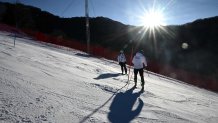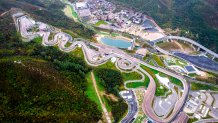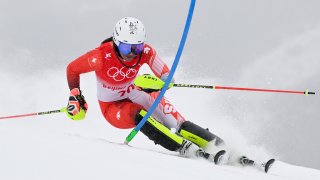During the first week of the 2022 Winter Olympics, we examined the danger and skill involved in landing a quadruple salchow in figure skating and soaring 50 feet in the air during free ski big air and snowboarding slopestyle. This week, we're taking a look at Alpine skiing and bobsled because they're both all about going downhill really fast.
There are a few types of skiing at the Winter Olympics. Alpine skiing basically means downhill skiing and includes several events, such as slalom, giant slalom and super-G, which all involve skiing between two poles, aka gates. Bobsled, or bobsleigh, also has a few versions based on the number of riders. Monobob means one rider and is only a women's event. There are also two- and four-person sleds.
The last Alpine skiing events are taking place Saturday, and bobsled is finishing Sunday, the last day of the 2022 Winter Games. Both events have already made major headlines, with U.S. Alpine skier Mikaela Shiffrin failing to clinch an individual medal and bobsledder Elana Meyers Taylor becoming the oldest American woman to win a medal at the Winter Olympics.
Alpine skiing at the Winter Olympics
When Dr. Dan O'Neill, who served as a team physician for the U.S. Alpine ski team, thinks about the sport, the first thing that comes to mind is "pure terror," he told NBCLX. "This is insane, what they're doing, the speeds they're going, 80 miles an hour in a skin suit."
One of the most crucial skills to thrive in Alpine skiing is pure strength. The men especially are built like "granite," he said. Why? You have "to hurl yourself down the mountain and have the strength to resist all the forces that are going through your body at that time" in order to precisely ski through your targets. You need strength not just in your legs and ankles but your core and arms, as well.

O'Neill has skied on some difficult tracks to tend to injured athletes and stressed that viewers at home can't understand just how icy and steep the hills are. What's more, changes in terrain depending on how the sun is shining make things even trickier. That's why it's crucial that Olympic skiers work with top-tier ski tuners, who help keep their skis in the best shape possible.
The sport is so challenging that skiers don't even need to make a mistake in order to injure themselves.
"A little wrinkle in the snow ... a little bit of sun in the wrong place [can] slow down your ski a little bit [and] can lead to catastrophic injuries," O'Neill said. "The variables are so enormous, and you just can't consider every variable."
He added that doctors most worry about spinal cord injuries with Alpine skiers because they can lead to the end of the athlete's career — or life. Other common injuries for Alpine skiers include shattered bones, torn ligaments and dislocated hips, which damage the body long term. But unsurprisingly, all the time skiers spend on skis seriously mitigates these risks.
O'Neill compared it to someone who lives in the Northeast walking on ice versus someone who lives in Florida. The person from the Northeast would probably be much better at it because they're used to it.
"[Skiing] is so ingrained in their muscle memory, so they're making these tiny adjustments constantly, and that's how they get away with doing what they're doing," he said.
Bobsledding at the Winter Olympics
Bobsleds can also reach speeds of up to 80 mph. For context, thoroughbred horses run about 40 mph, and electric scooters go about 18 mph.
Bobsleds vary in weight depending on the size and number of athletes, but a monobob with a rider usually clocks in around 540 lbs. while a four-man sled with riders is around 1,400 lbs. The speed and mass of the sleds create up to 5 Gs of force on the way down the run. That's five times the force of gravity and much more than you'd expect to feel while on a rocket launching into space, about 3.2 Gs.
With all this mind, now take in the fact that sledders have no protection besides the sled and helmet, and no seatbelt to hold their bodies in place, according to Dr. Joan Rubinger, founder of All Pro Sports Medicine.
This means a tremendous amount of strength and studying the course are necessary to come out of race uninjured, especially with multiple riders. To practice, sledders will usually go down a course for the first time at a slow speed and then add more acceleration each time.
Bobsled tracks usually have 15 or so turns, including a "labyrinth," or a section of the course with three tight turns in a row, not broken up by any straightaways. The one used in the 2022 Olympics has 16 turns.

"Sledders [have] to be in perfect alignment, and that means leaning their bodies just so and tilting their heads just so to achieve the perfect balance to achieve those perfect forces," Rubinger said.
To illustrate just how challenging that is, think about driving a go-kart and the way your body gets pushed around as the track curves.
"Imagine how much you're leaning, and these little turns are not even nearly as tight as these bobsleds are," Rubinger explained. In order to counterbalance and stay on course, you have to resist these forces, which are constantly trying to throw your body in what could be a dangerous direction.
So bobsledders have enormous core strength and also have to be good sprinters to get enough speed at the beginning of the race. But what injuries do they risk going down the track? Flipping over can result in shattered bones inside the bobsled and even lacerations to vital organs, according to Rubinger. Great Britain's two-man bobsled flipped over earlier this week, but luckily no one was hurt.
Rubinger also stressed that a common long-term injury among bobsledders is known as sled head, caused by the jackhammer-like motion on the brain from the force of sledding, which can lead to micro-concussions and seriously jeopardize brain health over time.
"The helmet rattles against the side of the sled, and the brain does the same thing inside the skull," she said. For that reason, "bobsled is by far one of the most dangerous Olympic sports, not just winter."


